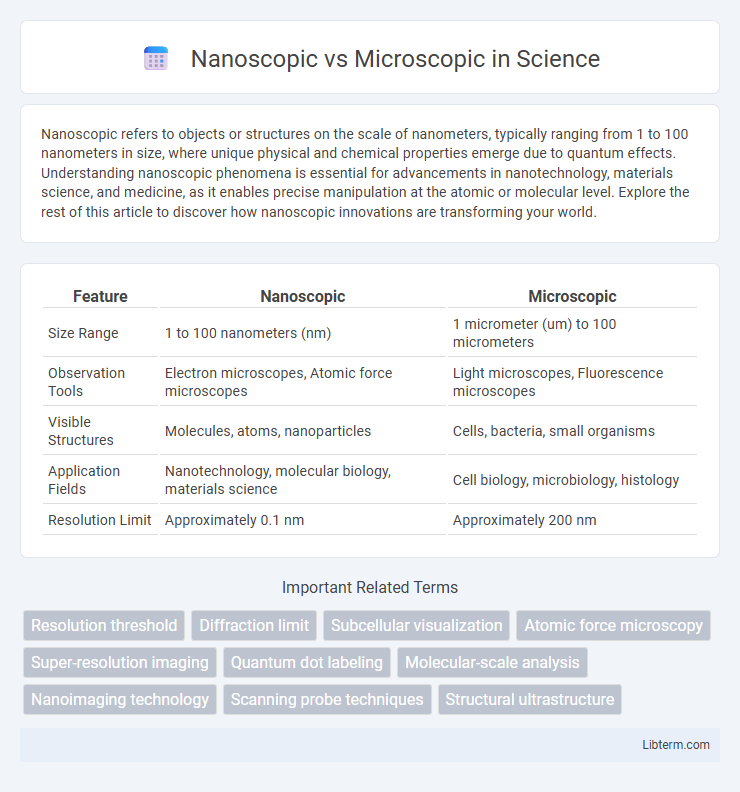Nanoscopic refers to objects or structures on the scale of nanometers, typically ranging from 1 to 100 nanometers in size, where unique physical and chemical properties emerge due to quantum effects. Understanding nanoscopic phenomena is essential for advancements in nanotechnology, materials science, and medicine, as it enables precise manipulation at the atomic or molecular level. Explore the rest of this article to discover how nanoscopic innovations are transforming your world.
Table of Comparison
| Feature | Nanoscopic | Microscopic |
|---|---|---|
| Size Range | 1 to 100 nanometers (nm) | 1 micrometer (um) to 100 micrometers |
| Observation Tools | Electron microscopes, Atomic force microscopes | Light microscopes, Fluorescence microscopes |
| Visible Structures | Molecules, atoms, nanoparticles | Cells, bacteria, small organisms |
| Application Fields | Nanotechnology, molecular biology, materials science | Cell biology, microbiology, histology |
| Resolution Limit | Approximately 0.1 nm | Approximately 200 nm |
Introduction: Understanding the Scale
Nanoscopic scale refers to dimensions typically below 100 nanometers, where atomic and molecular interactions dominate material properties, while microscopic scale covers objects visible under optical microscopes, ranging from about 1 micrometer to several millimeters. Understanding these scales is crucial in fields like nanotechnology and biology, as they determine the resolution and techniques used for observation and manipulation. The distinction influences the design of instruments such as electron microscopes for nanoscopic imaging and light microscopes for microscopic analysis.
Defining Nanoscopic and Microscopic
Nanoscopic refers to structures and entities measured on the scale of nanometers, typically between 1 and 100 nanometers, where quantum effects dominate and atomic-level details become significant. Microscopic pertains to objects visible under a microscope, generally ranging from 1 micrometer to several millimeters, encompassing cells and microorganisms that require optical magnification. Defining these scales is essential for understanding their applications in nanotechnology and microbiology.
Size Ranges: From Nano to Micro
Nanoscopic structures typically range from 1 to 100 nanometers, where individual atoms and molecules become distinguishable and quantum effects may dominate. Microscopic sizes span from approximately 100 nanometers up to 1 millimeter, covering cellular components, bacteria, and small organisms observable with optical microscopes. The transition from nano to micro scale marks a significant increase in feature size, influencing physical properties, imaging techniques, and applications in nanotechnology and biology.
Common Tools for Observation
Nanoscopic observation primarily relies on tools such as scanning tunneling microscopes (STM) and atomic force microscopes (AFM) to visualize structures at the atomic or molecular scale. Microscopic observation typically employs optical microscopes and electron microscopes, including transmission electron microscopes (TEM) and scanning electron microscopes (SEM), to view cellular and sub-cellular features. These tools differ significantly in resolution capabilities, with nanoscopic instruments achieving resolutions down to fractions of a nanometer, while microscopic devices generally resolve features in the micrometer to nanometer range.
Key Differences in Structure and Behavior
Nanoscopic structures measure less than 100 nanometers and exhibit quantum mechanical effects, influencing electrical, optical, and chemical properties uniquely compared to microscopic structures, which range from 1 micrometer to several millimeters and follow classical physics principles. Nanoscopic materials often demonstrate enhanced surface area-to-volume ratios, leading to increased reactivity and altered mechanical strength, whereas microscopic structures display more predictable bulk behavior and stability. The fundamental difference lies in scale-dependent phenomena: nanoscopic behavior is dominated by atomic and molecular interactions, while microscopic behavior reflects collective properties of large particle ensembles.
Applications in Science and Technology
Nanoscopic techniques enable manipulation and analysis of materials at the atomic or molecular scale, critical for advancements in nanotechnology, drug delivery systems, and semiconductor manufacturing. Microscopic methods, essential for studying cells, microorganisms, and microstructures, are widely applied in biology, materials science, and quality control in manufacturing. Both scales provide complementary insights, with nanoscopic tools driving innovation in molecular engineering, while microscopic tools facilitate understanding of larger structures and biological processes.
Impact on Medicine and Healthcare
Nanoscopic technologies enable targeted drug delivery systems that improve therapeutic efficacy and reduce side effects by interacting at the molecular level, surpassing microscopic methods in precision. Innovations like nanoscale imaging facilitate early disease detection and real-time monitoring, enhancing diagnostic accuracy beyond the capabilities of traditional microscopic techniques. The integration of nanotechnology in medicine accelerates personalized treatment plans and regenerative therapies, transforming healthcare outcomes significantly compared to microscopic approaches.
Challenges in Study and Analysis
Studying nanoscopic structures involves challenges such as the need for advanced imaging techniques like atomic force microscopy (AFM) and transmission electron microscopy (TEM) to visualize features at the scale of 1 to 100 nanometers, where conventional optical microscopes fail due to diffraction limits. Microscopic analysis, dealing with sizes from micrometers to millimeters, often encounters difficulties in sample preparation and achieving sufficient resolution without artifacts. Both fields require precise environmental control and specialized instruments to handle unique issues like quantum effects at the nanoscale and depth of field constraints in microscopic imaging.
Future Trends in Nano and Micro Research
Future trends in nano and micro research emphasize the integration of nanoscopic precision with microscopic scalability to enable breakthroughs in medicine, electronics, and materials science. Advances in nanofabrication techniques, such as atomic layer deposition and electron beam lithography, are driving the development of highly efficient nano-devices with applications in targeted drug delivery and quantum computing. Emerging research focuses on harnessing the unique properties of nanomaterials alongside micro-scale structures to create hybrid systems that enhance functionality and performance across multiple industries.
Conclusion: Importance of Scale in Science
Understanding the distinction between nanoscopic and microscopic scales is crucial for advancements in fields like materials science, biology, and nanotechnology. Nanoscopic scale, ranging from 1 to 100 nanometers, allows manipulation at the atomic and molecular level, enabling precision in drug delivery and electronic devices. Microscopic scale, typically from 1 micrometer to millimeters, provides vital insights into cellular structures and microorganisms, highlighting how scale directly impacts scientific observation and innovation.
Nanoscopic Infographic

 libterm.com
libterm.com